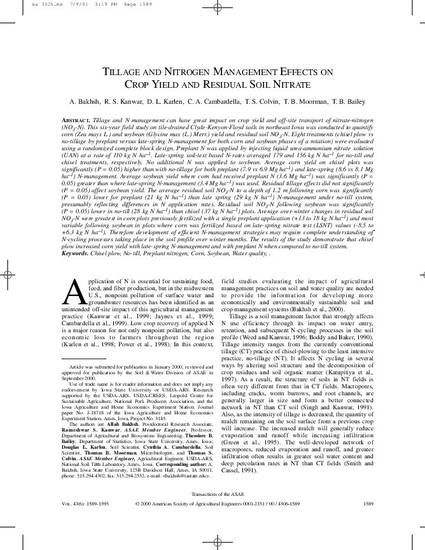
Tillage and N management can have great impact on crop yield and off-site transport of nitrate-nitrogen (NO 3 -N). This six-year field study on tile-drained Clyde-Kenyon-Floyd soils in northeast Iowa was conducted to quantify corn (Zea mays L.) and soybean (Glycine max (L.) Merr.) yield and residual soil NO 3 -N. Eight treatments (chisel plow vs no-tillage by preplant versus late-spring N-management for both corn and soybean phases of a rotation) were evaluated using a randomized complete block design. Preplant N was applied by injecting liquid urea-ammonium nitrate solution (UAN) at a rate of 110 kg N ha 1 . Late-spring soil-test based N-rates averaged 179 and 156 kg N ha 1 for no-till and chisel treatments, respectively. No additional N was applied to soybean. Average corn yield on chisel plots was significantly (P = 0.05) higher than with no-tillage for both preplant (7.9 vs 6.9 Mg ha 1 ) and late-spring (8.6 vs 8.1 Mg ha 1 ) N-management. Average soybean yield where corn had received preplant N (3.6 Mg ha 1 ) was significantly (P = 0.05) greater than where late-spring N-management (3.4 Mg ha 1 ) was used. Residual tillage effects did not significantly (P = 0.05) affect soybean yield. The average residual soil NO 3 -N to a depth of 1.2 m following corn was significantly (P = 0.05) lower for preplant (21 kg N ha 1 ) than late spring (29 kg N ha 1 ) N-management under no-till system, presumably reflecting differences in N application rates. Residual soil NO 3 -N following soybean was significantly (P = 0.05) lower in no-till (28 kg N ha 1 ) than chisel (37 kg N ha 1 ) plots. Average over-winter changes in residual soil NO 3 -N were greatest in corn plots previously fertilized with a single preplant application (+13 to 18 kg N ha 1 ) and most variable following soybean in plots where corn was fertilized based on late-spring nitrate test (LSNT) values (-8.5 to +6.3 kg N ha 1 ). Therefore development of efficient N-management strategies may require complete understanding of N-cycling processes taking place in the soil profile over winter months. The results of the study demonstrate that chisel plow increased corn yield with late-spring N-management and with preplant N when compared to no-till system.
Available at: http://works.bepress.com/rskanwar/174/

This article is published as Bakhsh, A., R. S. Kanwar, D. L. Karlen, C. A. Cambardella, T. S. Colvin, T. B. Moorman, and T. B. Bailey. "Tillage and nitrogen management effects on crop yield and residual soil nitrate." Transactions of the ASAE 43, no. 6 (2000): 1589. DOI: 10.13031/2013.3059. Posted with permission.